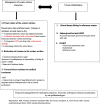Ocular sequelae of epidermal necrolysis: French national audit of practices, literature review and proposed management
- PMID: 36906580
- PMCID: PMC10007779
- DOI: 10.1186/s13023-023-02616-6
Ocular sequelae of epidermal necrolysis: French national audit of practices, literature review and proposed management
Abstract
Stevens-Johnson Syndrome (SJS) and toxic epidermal necrolysis (TEN) are serious and rare diseases, most often drug-induced, and their incidence has been estimated at 6 cases/million/year in France. SJS and TEN belong to the same spectrum of disease known as epidermal necrolysis (EN). They are characterized by more or less extensive epidermal detachment, associated with mucous membrane involvement, and may be complicated during the acute phase by fatal multiorgan failure. SJS and TEN can lead to severe ophthalmologic sequelae. There are no recommendations for ocular management during the chronic phase. We conducted a national audit of current practice in the 11 sites of the French reference center for toxic bullous dermatoses and a review of the literature to establish therapeutic consensus guidelines. Ophthalmologists and dermatologists from the French reference center for epidermal necrolysis were asked to complete a questionnaire on management practices in the chronic phase of SJS/TEN. The survey focused on the presence of a referent ophthalmologist at the center, the use of local treatments (artificial tears, corticosteroid eye drops, antibiotic-corticosteroids, antiseptics, vitamin A ointment (VA), cyclosporine, tacrolimus), the management of trichiatic eyelashes, meibomian dysfunction, symblepharons, and corneal neovascularization, as well as the contactologic solutions implemented. Eleven ophthalmologists and 9 dermatologists from 9 of the 11 centers responded to the questionnaire. Based on questionnaire results, 10/11 ophthalmologists systematically prescribed preservative-free artificial tears, and 11/11 administered VA. Antiseptic or antibiotic eye drops or antibiotic-corticosteroid eye drops were recommended as needed by 8/11 and 7/11 ophthalmologists, respectively. In case of chronic inflammation, topical cyclosporine was consistently proposed by 11/11 ophthalmologists. The removal of trichiatic eyelashes was mainly performed by 10/11 ophthalmologists. Patients were referred to a reference center for fitting of scleral lenses (10/10,100%). Based on this practice audit and literature review, we propose an evaluation form to facilitate ophthalmic data collection in the chronic phase of EN and we also propose an algorithm for the ophthalmologic management of ocular sequelae.
Keywords: Drug reaction; Eye; Management; Ocular involvement; Sequelae; Stevens-Johnson syndrome; Toxic epidermal necrolysis; Treatment.
© 2023. The Author(s).
Conflict of interest statement
The authors declare no competing interests.
Figures
References
-
- Chaby G, Maldini C, Haddad C, Lebrun-Vignes B, Hemery F, Ingen-Housz-Oro S, et al. Incidence of and mortality from epidermal necrolysis (Stevens-Johnson syndrome/toxic epidermal necrolysis) in France during 2003–16: a four-source capture-recapture estimate. Br J Dermatol. 2020;182:618–624. doi: 10.1111/bjd.18424. - DOI - PubMed
-
- Gueudry J, Roujeau J-C, Binaghi M, Soubrane G, Muraine M. Risk factors for the development of ocular complications of Stevens-Johnson syndrome and toxic epidermal necrolysis. Arch Dermatol. 2009;145:157–162. - PubMed
Publication types
MeSH terms
Substances
LinkOut - more resources
Full Text Sources
Research Materials



